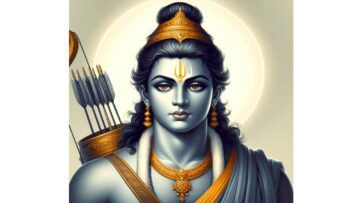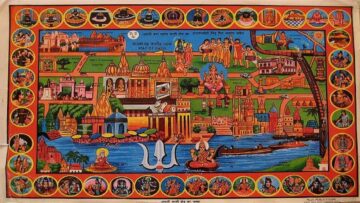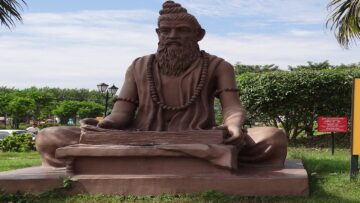In contemporary discourse, the system of castes in Hindu society is most often misunderstood. However, the book ‘Varna Vidya’ takes a unique and groundbreaking approach by examining the traditional rules and practices, especially for Women and Shudravarna, delving deep into the science behind the ancient societal system.
The author of the book, Sinu Joseph is a menstrual educator, author and her quest lies in the recognition of the need to validate the Bharatiya system of philosophy, such as Dharmashastra, Vedas and Upanishads. By embracing this ancient wisdom, we embark the journey of rediscovery and reclaiming the depth and breadth of knowledge which is already inherent in our cultural heritage. Author’s extensive knowledge of Sanskrit texts, modern scientific theories and sociological studies to present a robust analysis of the Varna dharma, such as biological basis of Chaturvarnya system, implications of women and Sudravarna officiating as Temple Archakas. Rather than disconnecting the ancient system of Varna, Varna Vidya seeks to understand and appreciate the wisdom that informed the dharmic practices for millennia. By carefully examining the Smritis, Bhagavad Gita, SrimadBhagavatam and Tantras texts, the author deconstructs the complex rules governing the women and Sudra Varna and reveals the truth.
In the context of Varna and Jati, the author explains the teachings of His Holiness Jagadguru Sri Chandrashekharendra Saraswathi, the 68th Pithadipathi of Sri Kanchi Kamakotipeetham or Mahaperiyava, who emphasizes the importance of not misinterpreting the exceptions granted to those who have reached Spiritual enlightenment and have attained the Samadi. The importance of understanding the true meaning of Samatvam or treating all beings as equal, as emphasized by Krishna in Bhagavad Gita. The author highlights how the concept of Samatvam is applicable only to those who are enlightened, have renounced worldly attachment or united with the divine.
Once a Russian professor named Ribakov, who wished to meet Mahaperiyava learnt valuable insights about the origin of his nation and its connection to ancient Vedic civilization. This incident exemplifies how Mahaperiyava recognized the unity of all human beings, regardless of their cultural or religious identities and emphasized the fundamental principles of considering everyone as a part of the same human fraternity. Expanding upon these ideas, the author contemplates whether the concepts of Varna and Jati should be limited only to Hindu society or if they are applicable to all humans.
Definition of varna as mentioned in the book:
~From Manu (I.XVII, 1.31), we have the following definition of the origin of varņa, which is similar to that of the PuruşaSūkta of the Rig-Veda (X.90.12):
लोकानां तु विवृद्ध्यर्थं मुखबाहूरुपादतः ।
ब्राह्मणं क्षत्रियं वैश्यं शूद्रं च निरवर्तयत् ॥ ३१ ॥
lokānāṃtuvivṛddhyarthaṃmukhabāhūrupādataḥ।
brāhmaṇaṃkṣatriyaṃvaiśyaṃśūdraṃcaniravartayat॥ 31 ॥
[With a view to the development of the (three) regions, He brought into existence the brahmaņa, the kṣatriya, the vaiśya and the śūdra, from out of His mouth, arms, thighs and feet (respectively)].
~ From YājñavalkyaSmrti (1.10), we have the following definition, which talks about who among the four varņa-s are considered as dvija (twice-born), thereby being eligible for mantra-based ceremonies:
ब्रह्मक्षत्रियविट्शूद्रा वर्णास्त्वाध्यास्त्रयो द्विजाः ।
निषेकाध्याः शमशानान्तास्तेषां वै मन्त्रतः क्रियाः ।। १०।।
brahmakṣatriyaviṭśūdrāvarṇāstvādhyāstrayodvijāḥ।
niṣekādhyāḥśamaśānāntāsteṣāṃvaimantrataḥkriyāḥ।। 10।।
[The varna-s are the brahmaņa-s, the ksatriya-s, the vaiśya-s and the śūdra-s. Of these, only the first three are dvija (twice- born); the performance of the ceremonies beginning with the rite (samskāra) of impregnation (garbhādhāna) and ending in the cremation ground (funeral rites of antyeśti), of these (of dvija-s) alone are prescribed with mantra-s.]
~ From VasisthaDharmasūtra (Chapter 3, verse 2 & 3), we have what is similar to the PuruşaSūkta, but in addition there is the most interesting definition of Varna in terms of metres (chandas), as follows:
ब्राह्मणोऽस्य मुखमासीद् बाहू राजन्यः कृतः ऊरू तदस्य यद्वैश्यः
पद्भ्यां शूद्रो अजायत इत्यपि निगमो भवति २
गायत्र्या ब्राह्मणमसृजत त्रिष्टुभा राजन्यं जगत्या वैश्यं न
केनचिच्छन्दसा शूद्रमित्यसंस्कार्यो विज्ञायते ३
brāhmaṇo’syamukhamāsīdbāhūrājanyaḥkṛtaḥūrūtadasyayadvaiśyaḥ
padbhyāṃśūdroajāyataityapinigamobhavati 2
gāyatryābrāhmaṇamasṛjatatriṣṭubhārājanyaṃjagatyāvaiśyaṃna
kenacicchandasāśūdramityasaṃskāryovijñāyate 3
[There is also the following passage of the Veda, “The brāhmaņa was his mouth, the kṣatriya formed his arms, the vaiśya his thighs; the śūdra was born from his feet. It has been declared in (the following passage of) the Veda that (a śūdra) shall not receive the sacraments, ‘He created the brāhmaņa with the gayatri (metre), the kșatriya with the tristubh, the vaiśya with the jagatī, the śūdra without any metre.”]
The author argues that these concepts are based on biological factors that exist across all humans. Hinduism is one of the few societies that has formalized and organized a system of classification known as Varna and Jati. The author opines that other societies may not have followed this system, but this does not mean that the fundamental biological difference among people does not exist.
On the cover page of the book, there is an original painting of the Hindu goddess, Sri Lalithambika Devi. The artwork is the virtual style of kerala murals and aims to serve as a source of spiritual insights for readers and connect them with the divine grace embodied by the goddess.
The first chapter focuses on the consequences of visiting Sri Vaikom Mahadeva temple, a prominent pilgrimage site in Kerala. Women who engaged in spiritual practices within the temple grounds, reported disturbance in their menstrual cycles, often experiencing earlier than expected periods, scantily flow and unusual physical sensations. The impact of various Yoga practices, including Kriya yoga, Hatha yoga and chanting practices aimed at raising the Kundalini and activating the pineal gland. These advanced techniques are believed to connect the practitioner with other dimensions. It can have detrimental effects on women’s physical and emotional health, if their bodies and minds are not prepared to handle such intensive experiences. The effect of breaking dharmic rules on women’s health and spiritual growth are not just conjecture but are supported by examining personal experiences. We can gain a deeper understanding of the subtle interconnections between physical, emotional and spiritual health, as well as the importance of following the rules prescribed by the sastras to protect and promote the wellbeing of women.
In the traditional Varņa system, the eligibility for upanayana samskara, which is the sacred thread ceremony, is limited to the three higher varnas – Brahmins, Kshatriya, and Vaisya. The Sudra Varna is excluded from this ceremony based on the rules mentioned in various Dharmashastra texts. As for girls and women, the upanayana samskara is traditionally not performed for them. However, it is important to note that interpretations and practices may vary within different communities and regions. In modern times, there are discussions and debates regarding the inclusion of women in traditionally male-centric rituals and ceremonies. Some families and communities have started performing modified versions of the upanayana samskara for girls as well, adapting to changing social norms and values. As we delve deeper into the scientific basis of varna dharma in subsequent chapters of this book, we will explore how these rules and practices have evolved over time and how they are perceived in contemporary society.
वैवाहिको विधिः स्त्रीणामौपनयनिकः स्मृतः ।
पतिसेवा गुरौं वासो गृहार्थाग्निपरिक्रिया ||
इति मनुवचनेन उपनयनस्थानापन्नो विवाह इति विवाहात् पूर्व
कामचारवादभक्षणं, विवाहानन्तरमेव नियमानुष्ठानम् ।
अतो वक्ष्यमाणधर्माः विवाहप्रभृत्येव ताभिरनुष्ठेयाः ।।
vaivāhikovidhiḥstrīṇāmaupanayanikaḥsmṛtaḥ।
patisevāgurauṃvāsogṛhārthāgniparikriyā ||
itimanuvacanenaupanayanasthānāpannovivāhaitivivāhātpūrva
kāmacāravādabhakṣaṇaṃ, vivāhānantaramevaniyamānuṣṭhānam।
atovakṣyamāṇadharmāḥvivāhaprabhṛtyevatābhiranuṣṭheyāḥ।।
[For women,’Marriage is upanayana, service to husband is service to Guru and household chores are “agnikriya”. With this statement of Manu (II.XV.67), marriage takes the place of upanayana in a woman’s life. Travel, food and speech are as per her likes before marriage and rules are to be followed after marriage!]
The connection between the chanting of the Gayatri mantra, activation of the Ajnacakra, and the role of the pituitary gland in regulating testosterone levels provides a holistic view of how spiritual practices can influence not only one’s spiritual growth but also physiological aspects such as hormonal balance and emotional regulation. The emphasis is on self-restraint, channeling energy positively by integrating biological factors with spiritual practices. This perspective offers a comprehensive understanding of how ancient traditions like mantra chanting can have profound effects on an individual’s physical, mental and spiritual well being. It highlights the interconnectedness of different aspects of human existence and emphasizes the importance of holistic approaches to personal growth and development.
From Sudrakamalakara, the guidelines regarding chanting of mantra-s for shudras and women is as mentioned in the book:
xxiv. अथ शूद्रस्य मन्त्रविचारः ॥ तत्र अविद्यत्वाद्वेदमन्त्रे
नाधिकारः ॥ व्यासोपि ॥
शूद्रो वर्णश्चतुर्थोपि वर्णत्वाद्धर्ममर्हति ॥
वेदमंत्रस्वधास्वाहा वषट्कारादिभिर्विनेति ॥ [व्या० स्मृ० अ० १ ० ६]
xxiv. athaśūdrasyamantravicāraḥ॥tatraavidyatvādvedamantre
nādhikāraḥ॥vyāsopi॥
śūdrovarṇaścaturthopivarṇatvāddharmamarhati॥
vedamaṃtrasvadhāsvāhāvaṣaṭkārādibhirvineti॥ [vyā0 smṛ0 a0 1 0 6]
[Regarding mantra eligibility for śūdra-s, because there is no Vedic education (no upanayanam) for śūdra-s, they have no eligibility for mantra-s. Even though Vyāsa has said that śūdra-s are also part of the four varņa-s and varņa dharma applies to them as well, that are not entitled to self-study of Veda, mantra japa, pitę karma, homa, śrauta karma/yāga, etc.]
xxv.नृसिंहतापिनीये ॥ सावित्रीं प्रणवं यजुर्लक्ष्मीं स्त्रीशूद्राय
नेच्छति ॥
पराशरभाप्येप्येवम् ॥ रामतापिनीये ॥ सावित्रीं लक्ष्मीं यजुः प्रणवं यदि
जानीयात्स्त्रीशूद्रः स मृतोधो गच्छति ॥
xxv.nṛsiṃhatāpinīye॥sāvitrīṃpraṇavaṃyajurlakṣmīṃstrīśūdrāya
necchati॥
parāśarabhāpyepyevam॥rāmatāpinīye॥sāvitrīṃlakṣmīṃyajuḥpraṇavaṃyadi
jānīyātstrīśūdraḥsamṛtodhogacchati॥
[As per NrsimhaTāpanīyaUpaniṣad, the Savitri mantra (as given in Yajur Veda), pranava (om), Yajur Laksmī³5 these are not desirable for women and śūdra-s. Parāśara has also said this. In Rama TapaniyaUpaniṣad, it is said that if women or śūdra-s learn Savitri, lakshmim (Śrībījam), yajuhpranava, after death, they will go to adholoka (lower worlds/realms).]
XXVI. गौडनिबन्धे तिथितत्त्वे स्कान्दे ॥ स्वाहा प्रणव संयुक्तं
शुभे मर्न
ददद्विजः ॥ शूद्रो निरयमामोति ब्रह्मणः शुद्धतामियात् ॥ एवं
पुराणविष्णु- सहस्रनामचण्डीस्तोत्रादिपाठेप्यनधिकारः ॥
XXVI. . gauḍanibandhetithitattveskānde॥svāhāpraṇavasaṃyuktaṃ
śubhemarna
dadadvijaḥ॥śūdronirayamāmotibrahmaṇaḥśuddhatāmiyāt॥evaṃ
purāṇaviṣṇu-sahasranāmacaṇḍīstotrādipāṭhepyanadhikāraḥ॥
[In Gaudanibandha, Tithitattva and SkandaPurana, it is said that if svähä mantra-s or pranava mantra-s are given by a brāhmaņa to a śūdra, then the südra will go to naraka and the brahmaņa will become a śūdra. Thus, there is no adhikāra for purāņa, VişnuSahasranama, chandistotram chanting, etc. for women and śüdra-s.]
xxvii. श्रवणमात्रेऽधिकारेण पाठाप्रसक्तेः ॥ तदुक्तं हरिवंशे ॥
xxvii.śravaṇamātre’dhikāreṇapāṭhāprasakteḥ॥taduktaṃharivaṃśe॥
[They have adhikāra only for śravana (listening), not for chanting. This is told in Harivamsha.]
xxviii. सुगतिमियाच्छ्रवणाच्च शूद्रजातिरिति ॥ अतएव भारते
विष्णुसहस्रनामसु ॥ वेदान्तगो ब्राह्मणः स्यात्क्षत्रियो विजयी
भवेत् ॥ वैश्यो धनसमृद्धः स्याच्छूद्रः सुखमवामुयात् ॥ [म० भा० अ० प० वि० श्लो० १-३]
इत्यत्र शुद्रः श्रवणेनैवेति शङ्कराचार्यैर्व्याख्यातम् ।।
xxviii. sugatimiyācchravaṇāccaśūdrajātiriti॥ataevabhārate
viṣṇusahasranāmasu॥vedāntagobrāhmaṇaḥsyātkṣatriyovijayī
bhavet॥vaiśyodhanasamṛddhaḥsyācchūdraḥsukhamavāmuyāt॥ [ma0 bhā0 a0 pa0 vi0 ślo0 1-3]
ityatraśudraḥśravaṇenaivetiśaṅkarācāryairvyākhyātam।।
[(With śravana alone) śūdra will attain happiness and this is what is meant in the phalaśruti portion of VişnuSahasranama which says that by listening to the sahasranama, brāhmaṇa-s will attain knowledge of the Veda, ksatriya-s will attain victory, vaiśya-s will obtain wealth, and śūdra-s will obtain happiness.]
This is (also) mentioned in Sri Sankarācārya’sbhāşyam, as follows,
तत्रैव हरिवंशवचनमाह सुगतिमिति ।
तथा च स्त्रीशूद्राणामितिहासपुराण गतस्तवपठने नाविकार इति भावः ॥ १२३ ॥
tatraivaharivaṃśavacanamāhasugatimiti।
tathācastrīśūdrāṇāmitihāsapurāṇagatastavapaṭhanenāvikāraitibhāvaḥ॥ 123 ॥
[Women and śūdra-s have no adhikāra to chant anything which is a part of Ithihāsa, purāņa-s. Hence, VişnuSahasranama, chandi etc. are prohibited to be chanted by śūdra-s and women.]
xxix. अमन्त्रस्येति विशेषणात् स्त्रीणां तत्तुल्यानां चेति शूलपाणिः ॥
xxix. amantrasyetiviśeṣaṇātstrīṇāṃtattulyānāṃcetiśūlapāṇiḥ॥
[Shoolapani says all these are applicable to women.]
While the dharmaśāstra rules are clear about the prohibition of Vedic mantra chanting for women and the śūdravarņa, there is some modification that can be made by simplifying the chants, as given in the below verses of the Sudrakamalākara:
xxx. All persons, including the śūdra-s and even candāla-s were authorised to repeat the Ramamantra of 13 letters (ŚrīRāmjayaRāmjayajaya Ram), and the Śiva mantra of 5 letters (namaḥśivāya), while dvijati-s could repeat the Śiva mantra of six letters (omnamaḥśivāya).
As discussed in the book, the concept of varna as a subtle vibrational quality extending beyond humans is indeed present in ancient texts of Bharat. The classification of varna among devatas, trees, animals, and even inanimate objects reflects the understanding that varna is not just a social classification based on occupation, but a deeper concept related to frequencies of vibration and aura. The association of specific qualities and characteristics with each varna in these classifications highlights the subtle nature of varna as a fundamental aspect of creation.
Dharma sastras derived from the sacred Vedas, is an extensive collection of Hindu texts that expands upon the perspective of dharmic living, in various aspects of life. It serves as a moral and legal guide for daily life, spiritual growth and the pursuit of ultimate liberation [Moksha]. Some of the most prominent Dharma sastras texts include Manu smriti, Yajnavalkyasmriti, Goutamadharmasastra and Parashuramasmriti. These texts cover a wide range of topics, such as religion duties, rituals, legal matters, customs and traditions and details about the four stages of life [Ashramas] and the four social classes [Varnas].
In addition to smriti texts, the dharma shastras also include Gruhya sutra texts that focus on domestic rituals and specific ceremonies related to daily life, marriage, purification and other events within the Hindus households. As we continue to explore the principles and teachings of dharma sastras, it is essential to maintain an open mind to new perspectives and interpretations by engaging in a critical analysis. We can strive to deepen our understanding of the complex and multifaceted nature of Hinduism, while also recognizing the importance of preserving the wisdom and insights of the ancient Indian sages who first compiled the sacred texts.
Varna Vidya is a thought provoking and insightful work that helps the readers to confront their preconceived notions about the caste system and to engage deeply with the rich spiritual and philosophical traditions of Hindu society. By understanding varna as a frequency of vibration and aura, we can interpret many of the rules and injunctions in the shastras pertaining to varna in a more meaningful way. This perspective helps us to appreciate the depth and complexity of the ancient wisdom preserved in the texts and provides insights into the interconnectedness of all aspects of existence through the concept of varna. It is a must read for anyone interested in understanding more about the complex and often misunderstood aspects of Bharath’s cultural heritage.
Disclaimer: The opinions expressed in this article belong to the author. Indic Today is neither responsible nor liable for the accuracy, completeness, suitability, or validity of any information in the article.











